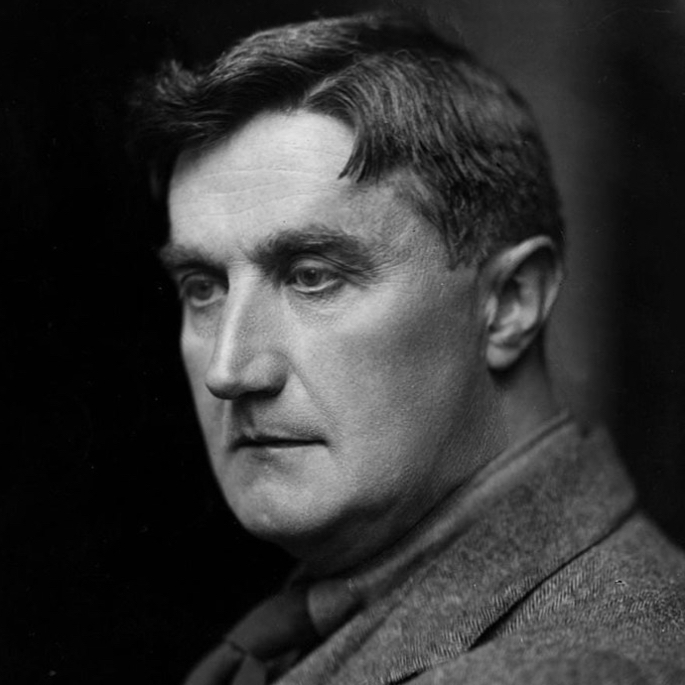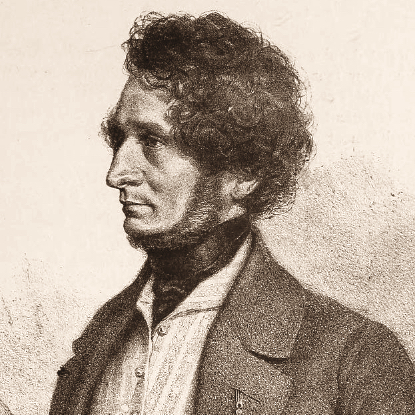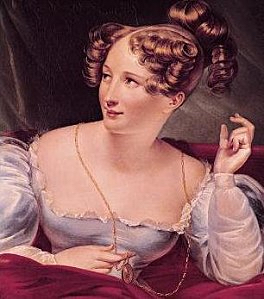NOTE: These program notes are published here for
patrons of the Madison Symphony Orchestra and other interested
readers. Any other use is forbidden without specific
permission from the author.
October 18-19-20, 2024
99th Season / Subscription
Program 2
J. Michael Allsen
Visions
lie at the heart of the works heard on this program,
which is led by guest
composer conductor Nicholas Hersh. British
composer Anna Clyne, whose music is making its first
appearance at a MSO
program, based her work This Midnight Hour upon
poetic visions by
Charles Baudelaire and Juan Ramón Jiménez. Violinist
Kelly Hall-Tompkins played a
stunning performance of the Wynton Marsalis Violin
Concerto in 2022. She
returns here to perform two works, beginning with the
gentle The Lark
Ascending by Ralph Vaughan Williams, based upon a
poem by George Meredith.
She then plays plays Tzigane, Maurice Ravel’s
virtuosic take on Roma
fiddling, written for the Hungarian violinist Jelly
d’Arani. And
to end the program we play the monumental
Symphonie fantastique by Hector Berlioz, a
passionate and often
disturbing musical vision ending with a trip to hell!
 Leading
British composer Anna Clyne, who now resides in New
York, wrote this exciting
work for L’Orchestre national d’Île-de-France in Paris.
Leading
British composer Anna Clyne, who now resides in New
York, wrote this exciting
work for L’Orchestre national d’Île-de-France in Paris.
Anna Clyne
Born: March 9, 1980,
London, United Kingdom.
This
Midnight Hour
- Composed: 2015.
- Premiere: November 13, 2015, in
Paris, by the
Orchestre national d'Île de France, Enrique Mazzola.
director.
-
Previous MSO Performances: This is our
first performance of the work.
-
Duration: 12:00.
Background
Clyne
frequently sees her works as collaborations, and many of
her orchestral works,
including this one, have arisen out of her
collaborations with the orchestras for
which she has been a composer-in-residence.
Among the leading
British composers of her generation, Anna Clyne was born
in London and was
composing by age 11. She studied at the University of
Edinburgh and the
Manhattan School of Music. Clyne has served as
composer-in-residence with the
Chicago Symphony Orchestra, the Baltimore Symphony
Orchestra, L’Orchestre
national d’Île-de-France in Paris, anD the Scottish
Chamber Orchestra. in
2024, she has just completed residencies with orchestras
in Finland, England,
and Spain. Clyne’s
inventive music spans
a wide range of styles, from electroacoustic works to
more traditional works
for orchestra, chamber ensembles, and chorus. This Midnight Hour was composed during her
residency in Paris
What You’ll Hear
This
evocative score draws upon images from poems by Jimenez
(of mad energy) and
Baudelaire (of a “melancholic waltz”).
Clyne
provides the following description of the piece:
“The
opening to This Midnight Hour is inspired
by the character and power of the lower strings of
L'Orchestre national d'Île
de France. From here, it draws inspiration from two
poems—one by Charles
Baudelaire and another by Juan Ramón Jiménez. Whilst it
is not intended to
depict a specific narrative, my intention is that it
will evoke a visual
journey for the listener. Jiménez’s La
musica is very
short
and concise:
“Music—
a naked woman
running mad through the pure night
(translated
by Robert Bly)
“This
immediately struck me as a strong image and one
that I chose to interpret with outbursts of frenetic
energy, for example,
dividing the strings into sub-groups that play fortissimo staggered descending cascade
figures from left to right
in stereo effect. This stems from my early explorations
of electroacoustic
music. There is also a lot of evocative sensory imagery
in Baudelaire’s Harmonie
du Soir, the first stanza of which reads as
follows:
“The season is at
hand when swaying on its stem
Every
flower exhales perfume like a
censer;
Sounds
and perfumes turn in the
evening air;
Melancholy
waltz and languid vertigo!
(translated
by William Aggeler)
“I
riffed on the idea of the melancholic waltz about
halfway into This Midnight Hour—I split the
viola section in two and
have one half playing at written pitch and the other
half playing 1/4 tone
sharp to emulate the sonority of an accordion playing a
Parisian-esque waltz.”
The piece starts
with hectic “running” music, with a forceful line from
the low strings and
jagged bursts from the woodwinds. Clarinets and
introduce a languid new idea
before a static interlude punctuated by the drums.
Another frantic episode
leads into Clyne’s rather woozy “melancholic waltz.” The
piece ends with a
calm, folklike idea, overlaid with a sometimes bluesy
solo trumpet.
 This
tranquil work was written directly after Vaughan
Williams returned home from the horrors of World War I.
This
tranquil work was written directly after Vaughan
Williams returned home from the horrors of World War I.
Ralph Vaughan Williams
Born: October 12, 1872, Down Ampney,
United Kingdom.
Died: August 26, 1958, London,
United Kingdom.
The Lark
Ascending
- Composed: Completed
in
1920.
- Premiere: Marie
Hall, to whom the score is dedicated, played The Lark Ascending at its first
performance, with piano
accompaniment, in December,
1920. Six
months later the composer’s friend Adrian
Boult conducted her in the premiere of the
orchestral version in London.
- Previous MSO Performances: We have
performed the work once previously, in 1978, with MSO
concertmaster Norman
Paulu as soloist.
- Duration: 13:00.
Background
Marie Hall, dedicatee of the
score, was a leading
British violinist of the day, and one of the first
female violinists to have a
truly international career.
Though he was nearly
42 at
the outbreak of World War I, Vaughan Williams
volunteered for service almost
immediately, setting composition aside for the duration
of the war. He served
first as an ambulance orderly and then as an artillery
officer, and at the end
of the war, he was named Music Director of the First
Army in France. Returning
to England, he took up a position
as Professor of Composition at the Royal College of
Music, and began composing
again with great intensity. Among the
works he had sketched out before the war was The Lark Ascending, and he revised the
score extensively in
1920. Vaughan
Williams dedicated it to
Marie Hall, one of the most eminent violin soloists of
the early 20th century.
Hall advised him on the solo part. One of the
reviewers said that it “showed serene disregard for
the fashions of today or
yesterday.” The Lark Ascending
is based upon a short poem by
the popular Victorian
writer George Meredith, which Vaughan Williams
includes in the score:
He rises and begins to round,
He drops the silver chain of sound,
Of many links without a break,
In chirrup, whistle, slur and shake.
For singing till his heaven fills,
‘Tis love of earth that he instils,
And ever winging up and up,
Our valley is his golden cup
And he the wine which overflows
To lift us with him as he goes.
Till lost on his aerial rings
In light, and then the fancy sings.
What You’ll Hear
The solo violin
winds
out a lovely melodic line above a lightly-scored
orchestral accompaniment.
 The work is an
exercise in serenity. The orchestra
begins with a hushed, expectant passage before the solo
line enters, ascending
to the violin’s upper range in a series of short phrases
reminiscent of
birdsong. This
outwardly simple melody
uses just a few pitches: one of my teachers jokingly
referred to this piece as
“Vaughan Williams’s loving tribute to the pentatonic
scale.” But it is
thoroughly lovely, played above the simplest
accompaniment. There
is a change of character, to a lyrical
theme played by the orchestra, as the solo part
“chirrups” a lively
decoration. Vaughan
Williams introduces
a new idea, a stolid folk dance that leads to an avian
cadenza. The
orchestra introduces a third theme, a
broad folklike melody.
The piece closes
with a final reprise of the opening music, and a solo
violin passage that fades
to nothingness as the lark vanishes in the misty
heights.
The work is an
exercise in serenity. The orchestra
begins with a hushed, expectant passage before the solo
line enters, ascending
to the violin’s upper range in a series of short phrases
reminiscent of
birdsong. This
outwardly simple melody
uses just a few pitches: one of my teachers jokingly
referred to this piece as
“Vaughan Williams’s loving tribute to the pentatonic
scale.” But it is
thoroughly lovely, played above the simplest
accompaniment. There
is a change of character, to a lyrical
theme played by the orchestra, as the solo part
“chirrups” a lively
decoration. Vaughan
Williams introduces
a new idea, a stolid folk dance that leads to an avian
cadenza. The
orchestra introduces a third theme, a
broad folklike melody.
The piece closes
with a final reprise of the opening music, and a solo
violin passage that fades
to nothingness as the lark vanishes in the misty
heights.
 Hungarian music,
particularly that
of the Roma people, has been fascinating composers from
the time of Mozart
onwards. This work by Ravel attempts to capture the
excitement of Roma
fiddling.
Hungarian music,
particularly that
of the Roma people, has been fascinating composers from
the time of Mozart
onwards. This work by Ravel attempts to capture the
excitement of Roma
fiddling.
Maurice Ravel
Born: March 7, 1875, Ciboure, France.
Died: December
28, 1937, Paris, France.
Tzigane
- Composed: 1922-24.
- Premiere: A version
for violin and piano was premiered in London by Jelly
d’Arani, violin, and
Henri Gil-Marchex, piano, on April 26, 1924. Ravel
completed the orchestral
version a few months later, and this version was
premiered in Paris on November
30, 1924, with d’Arani as soloist.
- Previous MSO Performances: Previous MSO
performances have featured Vartan Manoogian (1982) and
Laura Frautschi (1997).
-
Duration: 10:00.
Background
Jelly d’Arani, the Hungarian
violinist who inspired Ravel to compose this work, had
settled in London by 1922,
after years of successful tours. She was an excellent
player, but also did not
shy away from using her “exotic” Roma heritage to
further her career.
 During the early 1920s,
Maurice Ravel was in a severe compositional slump. His
spirit and Parisian
musical society had been devastated by World War I, and
he was deeply depressed
over the death of his mother. He managed to complete his
Violin Sonata in 1922, but the years
leading up to this were
extremely unproductive. In July of 1922, Ravel was
invited to a private concert
where the Hungarian violinist Jelly d’Arani played the
recently-completed
sonata. Ravel was entranced by her playing, and was
particularly fascinated by
her Hungarian musical heritage. He asked her to play
some authentic Roma tunes,
and eventually the two stayed together until 5:00 in the
morning, discussing
Hungarian music. Tzigane
(meaning
“Gypsy”) was obviously inspired by this experience, and
although it was
relatively slow in coming, it marked the beginning of a
new period of
creativity for Ravel.
During the early 1920s,
Maurice Ravel was in a severe compositional slump. His
spirit and Parisian
musical society had been devastated by World War I, and
he was deeply depressed
over the death of his mother. He managed to complete his
Violin Sonata in 1922, but the years
leading up to this were
extremely unproductive. In July of 1922, Ravel was
invited to a private concert
where the Hungarian violinist Jelly d’Arani played the
recently-completed
sonata. Ravel was entranced by her playing, and was
particularly fascinated by
her Hungarian musical heritage. He asked her to play
some authentic Roma tunes,
and eventually the two stayed together until 5:00 in the
morning, discussing
Hungarian music. Tzigane
(meaning
“Gypsy”) was obviously inspired by this experience, and
although it was
relatively slow in coming, it marked the beginning of a
new period of
creativity for Ravel.
What You’ll Hear
Though they were closely
contemporary
pieces, Ravel takes an approach in Tzigane
that is entirely different from that of
Vaughan-Williams: here the focus is
entirely on the violin part, which is filled to the brim
with astonishing
technical feats.
Ravel’s friend,
violinist
André Polah, who advised him on technical details of the
solo part, wrote that:
“Ravel’s idea was to represent a [Roma violinist]
serenading a beautiful
woman—real or imaginary—with his fiery temperament and
with all the resources
of good and bad taste at his command. In the solo part,
Ravel has not only uses
every known technical effect, but has invented some new
ones!” Ravel was
particularly adept at absorbing musical influences, and
in Tzigane he creates his own version of
Hungarian music. The work
opens with a lengthy and spectacular solo cadenza that
manages to capture the
essence of Roma fiddling, together with echoes of the
19th-century violin
virtuoso Niccoló Paganini. When the orchestra finally
enters, it provides a
rich, but inobtrusive background to an
ever-more-complicated battery of
virtuoso techniques: rapid harmonics, quadruple stops,
and an amazing passage
that calls upon the player to play pizzicatti
with the left hand in the midst of bowed arpeggios.
 Okay, I’m just
going to say it:
Hector Berlioz was one strange dude...
Okay, I’m just
going to say it:
Hector Berlioz was one strange dude...
Hector Berlioz
Born: December
11, 1803, La
Côte-Saint-André,
France.
Died: March
8, 1869, Paris, France.
Symphonie
fantastique (Fantastic
Symphony), Op. 14
- Composed: Berlioz’s
Symphonie
fantastique, which he
subtitled “Episode in the Life of an Artist,” was
written between 1829 and
1830.
- Premiere: December
5, 1830 at the Paris Conservatoire, under the
direction of François-Antoine
Habaneck.
- Previous MSO Performances: Previous performances by the
Madison Symphony
Orchestra were in 1973, 1983, 1997, 2006 and 2015.
-
Duration: 55:00.
Background
This grand, programmatic work
was
inspired by Berlioz’s obsessive love for English actress
Harriet Smithson.
If we were to paint
a picture
of the archetypical Romantic Composer, we could probably
use Hector Berlioz as
a model. Six
feet tall, with a huge mop
of hair and a passionate personality, Berlioz was nearly
always in a state of
emotional upheaval—upheaval reflected in his copious
writings and
larger-than-life compositions. All of his compositions
illustrated his
passions, but none is more directly (and disturbingly)
autobiographical than
his Symphonie
Fantastique.
The story behind this work reads like a
Hollywood screenplay...
 Scene
1: Paris,
1827.
Berlioz (a young Gérard Depardieu? Johnny Depp in
a red wig?), a
passionate young composer, sees Shakespeare’s Hamlet for the first time.
He is in ecstasy over the play, despite the fact
that the performance
was in English, a language he does not understand. What really
makes an impression on him, however, is Harriet
Smithson, the English actress
in the role of Ophelia (if contemporary descriptions of
her are accurate, Lena
Dunham would be perfect.) Berlioz is immediately
obsessed with Smithson, and
writes to her with a marriage proposal—the first of
dozens of love letters. Rather
than taking out a restraining order, she simply leaves
Paris in 1829 without
ever acknowledging Berlioz’s existence.
Scene
1: Paris,
1827.
Berlioz (a young Gérard Depardieu? Johnny Depp in
a red wig?), a
passionate young composer, sees Shakespeare’s Hamlet for the first time.
He is in ecstasy over the play, despite the fact
that the performance
was in English, a language he does not understand. What really
makes an impression on him, however, is Harriet
Smithson, the English actress
in the role of Ophelia (if contemporary descriptions of
her are accurate, Lena
Dunham would be perfect.) Berlioz is immediately
obsessed with Smithson, and
writes to her with a marriage proposal—the first of
dozens of love letters. Rather
than taking out a restraining order, she simply leaves
Paris in 1829 without
ever acknowledging Berlioz’s existence.
Scene 2: Paris,
1830.
Berlioz has just completed the Symphonie
fantastique, an enormous five-movement
programmatic work, which details his
obsession with Harriet, including a drug-induced dream
sequence in which he
kills her and goes to Hell. The work is
controversial, but highly successful. Berlioz is happy
for the time being, and
has a new love interest, the pianist Camille Moke
(Gwyneth Paltrow).
Scene 3: Paris,
1832.
Berlioz, dumped by Camille, is despondent and
considering suicide.
Harriet is in town again, and an English gossip
columnist talks her into
attending a performance of the Symphonie
fantastique.
(The inspiration for Berlioz’s symphony is an open
secret, and her presence at
the concert is sure to stir things up...) Harriet savors
the attention, and
begins to pay some serious
attention
to Berlioz. The
two are married a year
later.
Epilogue.
Like most affairs based upon obsession, the
real thing turns out to be not as good as the fantasy. Within a year
of their marriage, Mr. and Mrs.
Berlioz are miserable.
They stick
together for ten unpleasant years, and are eventually
divorced in 1844. Berlioz
does not feel truly free of the
relationship until 1854, when Harriet dies.
He is married to his second wife a few weeks
later. [Note: I’m not making
any of this up! -
J.M.A.]
What You’ll Hear
The Symphonie fantastique is perhaps the
prototypical romantic program
symphony, the work that set the tone for many symphonies
and symphonic poems to
come. Not only is it intensely emotional, it is based
upon a distinct program:
a story Berlioz wants us to follow in the work.
The work that grew
out of
this strange affair, the Symphonie
fantastique,
is a landmark in the history of romantic music. Written
for a huge orchestra,
this work uses orchestral effects and even instruments
that had never been used
in a symphony. (This
is, for example,
the first appearance of the tuba—or rather its ancestor,
the ophicleide—in a piece
of orchestral music.)
Even more striking
is the programmatic idea behind Berlioz’s score. This is not
the first programmatic
symphony—Berlioz himself credits Beethoven’s “Pastoral”
symphony as
inspiration—but it is the first in which the
extra-musical story line is so
explicit. In
a story that has echoes of
Goethe’s dark Faust,
Berlioz
musically describes his obsession in great detail, even
going to the extent of
publishing a written program as an aid to the audience’s
imagination. To
illustrate his affair, he creates a
musical idée fixe
(literally “fixed
idea” or “obsession”) representing his changing view of
his beloved. This
idea appears in each movement, but each
time in a different character: as a flowing Romantic
melody in the opening
movement, as a lilting waltz in the second, as a
shepherd’s song in the third,
and in the fourth movement, it is the last thing the
condemned artist thinks of
before the blade of guillotine drops.
Its final appearance is as a mocking dance in the
“Witches’ Sabbath”
movement. The program Berlioz wrote to accompany the Symphonie Fantastique is as follows:
“Part I: Reveries—Passions.
The author
imagines that a young musician, afflicted with that
moral disease that a
well-known writer calls the vague des
passions, sees for the first time a woman who
embodies all the charms of
the ideal being he has imagined in his dreams, and falls
desperately in love
with her. Through
an odd whim, whenever
the beloved image appears in the mind’s eye of the
artist, it is linked with a
musical thought whose character, passionate but at the
same time noble and shy,
he finds similar to the one he attributes to his
beloved. This melodic image
and the model it reflects pursue him incessantly like a
double idée fixe. That is the
reason for the constant
appearance, in every moment of the symphony, of the
melody that begins the
first Allegro. The passage
from this state of melancholy
reverie, interrupted by a few fits of groundless joy, to
one of frenzied
passion, with its moments of fury, of jealousy, its
return of tenderness, its
tears, its religious consolations—this is the subject of
the first movement.
“Part II: A Ball. The
artist finds himself in the
most varied situations—in the midst of the
tumult of a party, in the peaceful contemplation
of nature; but
everywhere, in the town, in the country,
the beloved image appears before him and disturbs his
peace of mind.
“Part III: Scene in the
Country. Finding
himself one evening in the country, he hears in the
distance two shepherds
piping a ranz de
vaches [shepherd’s
song] in dialogue.
This pastoral duet,
the scenery, the quiet rustling of the trees gently
brushed by the wind, the
hopes he has recently found reason to entertain—all come
together to afford his
heart an unaccustomed calm, and in giving a more
cheerful color to his
ideas. He
reflects upon his
isolation; he
hopes that his loneliness
will soon be over.
But what if she were
deceiving him! This
mingling of hope and
fear, these ideas of happiness disturbed by black
presentiments, form the
subject of the Adagio. At the end,
one of the shepherds takes up the
ranz des vaches; the other no
longer replies. Distant
thunder—loneliness—silence.
“Part
IV: March to the Scaffold.
Convinced that his love is unappreciated,
the artist poisons himself with opium.
The dose of narcotic, too weak to kill him,
plunges him into a sleep
accompanied by the most horrible visions.
He dreams that he has killed his beloved, that he
is condemned to death
and led to the scaffold, and that he is witnessing his own execution. The
procession moves forward to the sounds of a march that
is sometimes somber and
fierce, and sometimes brilliant and solemn, in which the
muffled sound of heavy
steps gives way without transition to the noisiest
clamor. At
the end, the idée fixe returns for a moment, like a
final thought of love before
the fatal blow.
“Part V: A Witches'
Sabbath. He sees
himself at the sabbath, in the midst of a frightful
troop of ghosts, sorcerers,
and monsters of every species, all gathered for his
funeral; strange noises,
groans, bursts of laughter, distant cries which other
cries seem to
answer. The
beloved melody appears
again, but it has lost its character of nobility and
shyness; it
is now no more than a dance tune, mean,
trivial and grotesque.
It is she, coming
to join the sabbath … a roar of joy at her arrival. She takes part
in the devilish orgy—funeral
knell—burlesque parody of the Dies irae—sabbath
round-dance—the
sabbath round-dance and the Dies
irae combined.”
_____
program notes ©2024 by J.
Michael
Allsen